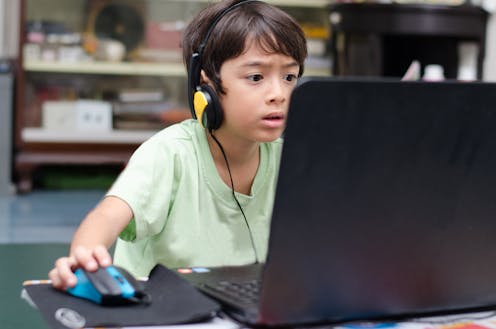Videogames or homework? Why not both, as ACMI has 75 game lessons for you to try
- Written by Amber McLeod, Lecturer in Education, Monash University

Despite the growth of technology in our daily lives, the integration of digital technologies into education has been slower than anticipated. There seem to be a number of factors at work here, including problems with access to technology and the time and support needed to use technology successfully in the classroom.
Teachers may also lack confidence in choosing and using technology or believe technology will not improve learning.
Australia’s national museum for screen culture, ACMI, has released an online digital learning lesson bank to address these challenges. This is part of ACMI’s school program and resources database. Game Lessons offers digital games as lessons – 25 lesson plans comprising 75 digital lessons. These are created by expert teachers and include areas such as the arts, humanities, sciences, literacy and capabilities such as ethics.
The new resource is an interesting step forward that builds on the existing pedagogy of digital game-based learning. This refers to the use of games to teach content.
Read more: Gaming in the classroom: what we can learn from Pokémon Go technology
A brief history of digital education
Digital games such as Maths Rescue and Carmen Sandiego have been used in education for as long as computers have been available in classrooms.
The developers of globally-popular games such as Minecraft, Fortnight and Portal 2 have already capitalised on their potential in education. They’ve all developed educational versions of their games with supporting lesson plans and online communities.
Playing fun games that interest and motivate students is a key aspect of digital-based learning. Games, however, include other educationally useful features:
students can work at their own pace, or collaborate in a team
students practise skills until they are achieved and then move to a higher level. This provides experiences of mastery, continual assessments and immediate feedback
games automatically adjust to the level of difficulty needed to encourage student persistence. Students then gain rewards for hard work including virtual lives, coins or badges
transferable skills such as communication skills, strategising and problem solving are essential for collaborative gameplay. It also fosters creativity, flexibility and resilience skills
activities become more student-centred and students can be positioned as experts co-constructing knowledge with their teacher. This is a powerful motivator.
The research into the effectiveness of game-based learning seems highly contextual. A 2017 study examined the way teachers designed 27 game-based learning courses from middle school to higher education, including the specific game elements they used and why. It found
The structure of game-based learning at different levels will vary to meet the developmental and academic needs of students, but more work is needed in determining which strategies are most effective for learning.
Another study found many teachers feel unsure about using games in specific classes.
So, what is the ACMI resource?
ACMI’s Game Lessons are connected to the Victorian Curriculum and can be searched by learning area and year level, from foundation to year 12. To support these resources, ACMI also has professional development opportunities and peer to peer interactions in a Slack community.
Teachers are encouraged to pick and choose and adapt the most useful or inspirational aspects of the plans for their classrooms. They can leave out those aspects not meeting their needs.
Read more: How creative use of technology may have helped save schooling during the pandemic
In the lesson plans, students are no longer positioned simply as learners but as having active roles including watchers, players, makers or explorers. In some lessons they simply watch YouTubers playing games; in others they make their own online or offline games.
In one lesson, called Gone Home the players are immersed in a story where the protagonist is a mystery but players discover more about her through narration and the exploration of objects. This is a historical video game to develop skills in evaluating evidence.
In Gone Home, players figure out the mystery of the protagonist while learning about historical concepts.Another video game is called Contraption Maker. Here students learn physics by becoming explorers in sandbox or simulation games and invent, tinker and test their ideas. A sandbox is a style of game in which minimal character limitations are placed on the gamer, allowing them to roam and change a virtual world at will.
In Contraption Maker a physics sandbox allows players to explore energy and energy transfers/transformations.Games such as the ones in the new ACMI resource can be seen as another tool in a teacher’s toolbox. The technology may be used as a stimulus for a main teaching activity, such as a writing task, in the same way a book, video, excursion or objects are currently used.
Maintaining momentum
The continual renewal of learning technology is relentless. It forces teachers to think twice before embracing this type of resource in case the technologies become redundant within a year or two.
For ongoing success, ACMI will need to ensure the Games Lessons library continues to meet the International Standards for Technology in Education. The library would need to meet current needs and anticipate future needs too.
Game Lessons is an ACMI education initiative funded by the Department of Education Victoria’s Strategic Partnerships Program, and supported by a committed network of teachers.
Authors: Amber McLeod, Lecturer in Education, Monash University





